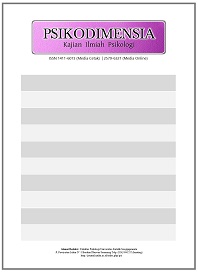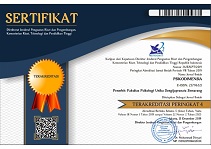Personalized Online Advertisements as A Means of Enhancing Purchase Intention:The Mediating Effect of Advertising Value
Abstract
Keywords
Full Text:
PDFReferences
Analytic Data Advertising (2020). 4 Data-Driven Strategies For Southeast Asian Marketers As Covid-19 Further Threatens Economic Decline. Retrieved from https://ada-asia.com/data-driven-strategies-for-southeast-asian-marketers-as-covid-19-further-threatens-economic-decline/
Ahn, R.J. (2014). The Interplay Of Advertising Choice And Involvement On Psychological Reactance, Attitudes, And Intentions In The Context Of Online Video Advertising. Tesis. University of Illinois. Illinois.
Ajzen, I. (1985). From Intentions to Action: A Theory of Planned Behavior. New York: Springer.
Bang, H., & Wojdynski, B. W. (2016). Distraction Effects of Contextual Advertising on Online News Processing: An Eye-Tracking Study. Journal Behaviour and Information Technology, 35.
Baron, R. M., & Kenny, D. A. (1986). The Moderator-Mediator Variable Distinction in Social The Moderator-Mediator Variable Distinction in Social Psychological Research: Conceptual, Strategic, and Statistical Considerations. Journal Pers. Social Psychology.
Blackwell, R. D., Miniard, P. W., & Engel, J. F. (2006). Consumer Behavior 10th Edition. Ohio: Thomson/South-Western.
Campbell, D. E., Wright, R. T., & Clay, P. F. (2010). Deconstructing and operationalizing interactivity: an online advertising perspective. JITTA: Journal of Information Technology Theory and Application, 11(4), 29.
Chung, T. S., Wedel, M., & Rust, R. T. (2016). Adaptive Personalization Using Social Networks. Journal of the Academy of Marketing Science.
DeZoysa, S. (2002) Mobile advertising needs to get personal. Telecommunications International, 36 (2): 8.
Ducoffe, R. (1996). Advertising value and advertising on the web. Journal of Advertising Research, 36(5), 21–34
Google & TEMASEK. (2018, November). e-Conomy SEA 2018 Southeast Asia’s Internet Economy Hits an Inflection Point. Retrieved from https://www.thinkwithgoogle.com/intl/en-apac/tools-resources/research-studies/e-conomy-sea-2018-southeast-asias-internet-economy-hits-inflection-point/
Hawkins, D. I., & Mothersbaugh, D. L. (2010). Consumer behavior: Building marketing strategy. Boston: McGraw-Hill Irwin.
Ho, Shuk Ying & Ho, Kevin K. (2008). "The Effects of Web Personalization on Influencing Users' Switching Decision to a New Website". Pacis 2008 Proceedings. Paper 67.
Hong, I.-B., & Cho, H.-H. (2011). The impact of consumer trust on attitudinal loyalty and purchase intentions in B2C e-marketplaces: Intermediary trust vs. seller trust. International Journal of Information Management, 31(5), 469–479.
Howard, D. J., & Kerin, R. A. (2004). The effects of personalized product recommendations on advertisement response rates: The “try this. It works!” technique. Journal of User Psychology, 14(3), 271–279
Katadata (2020, Mei). E-commerce Tumbuh di tengah Pandemi Covid-19. Retrieved from https://katadata.co.id/infografik.
Kim, Y. J., & Han, J. (2014). Why smartphone advertising attracts users: A model of web advertising, flow, and personalization. Computers in Human Behavior, 33, 256–269.
Lee, Y. G., Byon, K. K., Ammon, R., & Park, S. B. R. (2016). Golf product advertising value, attitude toward advertising and brand, and purchase intention. Social Behavior and Personality: an international journal, 44(5), 785-800.
Li, D., & Browne, G. J. (2006). The role of need for cognition and mood in online flow experience. Journal of Computer Information Systems, 46(3), 11.
Liu, C.-L. E., Sinkovics, R. R., Pezderka, N., & Haghirian, P. (2012). Determinants of consumer perceptions toward mobile advertising — A comparison between Japan and Austria. Journal of Interactive Marketing, 26(1), 21–32.
Logan, K., Bright, L. F., & Gangadharbatla, H. (2012). Facebook versus television: Advertising value perceptions among females. Journal of Research in Interactive Marketing, 6(3), 164–179.
Mikalef, P., Giannakos, M., & Pateli, A. (2013). Shopping and word-of-mouth intentions on social media. Journal of Theoretical and Applied Electronic Commerce Research, 8(1), 17–34.
O’Donnell, K. & Cramer, H. (2015) “People’s Perceptions of Personalized Ads”, Proceedings of the International World Wide Web Conference Committee (IW3C2).
PubMatic. (2019). 2019 Global Digital Ad Trends. Retrieved from https://pubmatic.com/reports/2019-global-digital-ad-trends/
Rao, B. & Minakakis, L. (2003). Evolution of e-mail location-based services. Communications of the ACM 46 (12): 61–65.
Robas, Fatima Rashid Hanoun. (2012). "Personalized Online Advertising In Social Network Sites; Investigating The Role Of Privacy Concerns And Self-Reference Propensity In The Effectiveness Of Personalized Online Advertising In Social Network Sites". Tesis. Graduate School of Communication. University Of Amsterdam. Amsterdam.
Robins, F. (2003) The marketing of 3G. Marketing Intelligence & Planning 21 (6): 370–378.
Saadeghvaziri, F. J., & Hosseini, H. K. (2011). Mobile advertising: An investigation of factors creating positive attitude in Iranian customers. African Journal of Business Management, 5(2), 394–404.
Stephen, A. T. (2016). The role of digital and social media marketing in consumer behavior. Current Opinion in Psychology, 10, 17-21.
Sunikka, Anne., & Bragge, J. (2008). "What, Who and Where : Insight into Personalization". 41st Hawaii International Conference on System Sciences. 283- 293.
Tsai, M.T., Cheng, N.C., & Chen, K.S. (2011). Understanding Online Group Buying Intention: The Roles of Sense of Virtual Community and Technology Acceptance Factors. Total Quality Management, vol. 22, no. 10.
Tucker, C. E. (2014). Social Networks, Personalized Advertising and Privacy Controls. Journal of Marketing Research. 51(5): 546-562.
Ünal, S., Erci, A., & Keser, Ercan. (2011). Attitudes towards mMobile advertising – A research to determine the differences between the attitudes of youth and adults. Procedia Social and Behavioral Sciences, 24, 361–377.
Wang, Y. S., Yeh, C. H., & Liao, Y. W. (2013). What drives purchase intention in the context of online content services? The moderating role of ethical self-efficacy for online piracy. International Journal of Information Management, 33(1), 199–208.
Wu, P. C. S., Yeh, G. Y. Y., & Hsiao, C. R. (2011). The effect of store image and service quality on brand image and purchase intention for private label brands. Australasian Marketing Journal, 19, 30–39.
Xu, D. J., Liao, S. S., & Li, Q. (2008). Combining empirical experimentation and modeling techniques: A design research approach for personalized mobile advertising applications. Decision Support Systems, 44(3), 710–724
DOI: https://doi.org/10.24167/psidim.v19i2.2650
Print ISSN : 1411-6073 | online ISSN : 2579-6321 View My Stats

This work is licensed under a Creative Commons Attribution 4.0 International License.




















